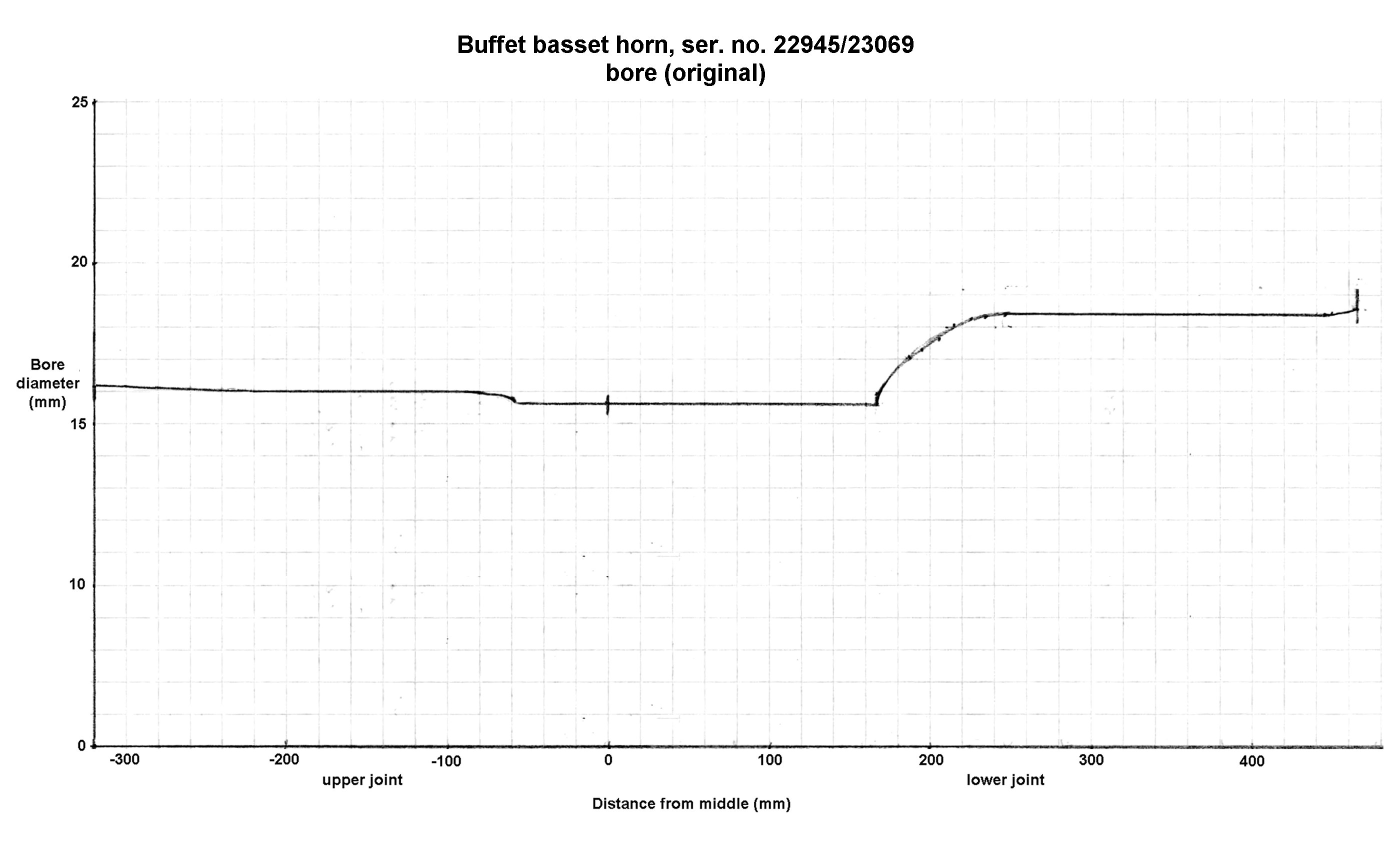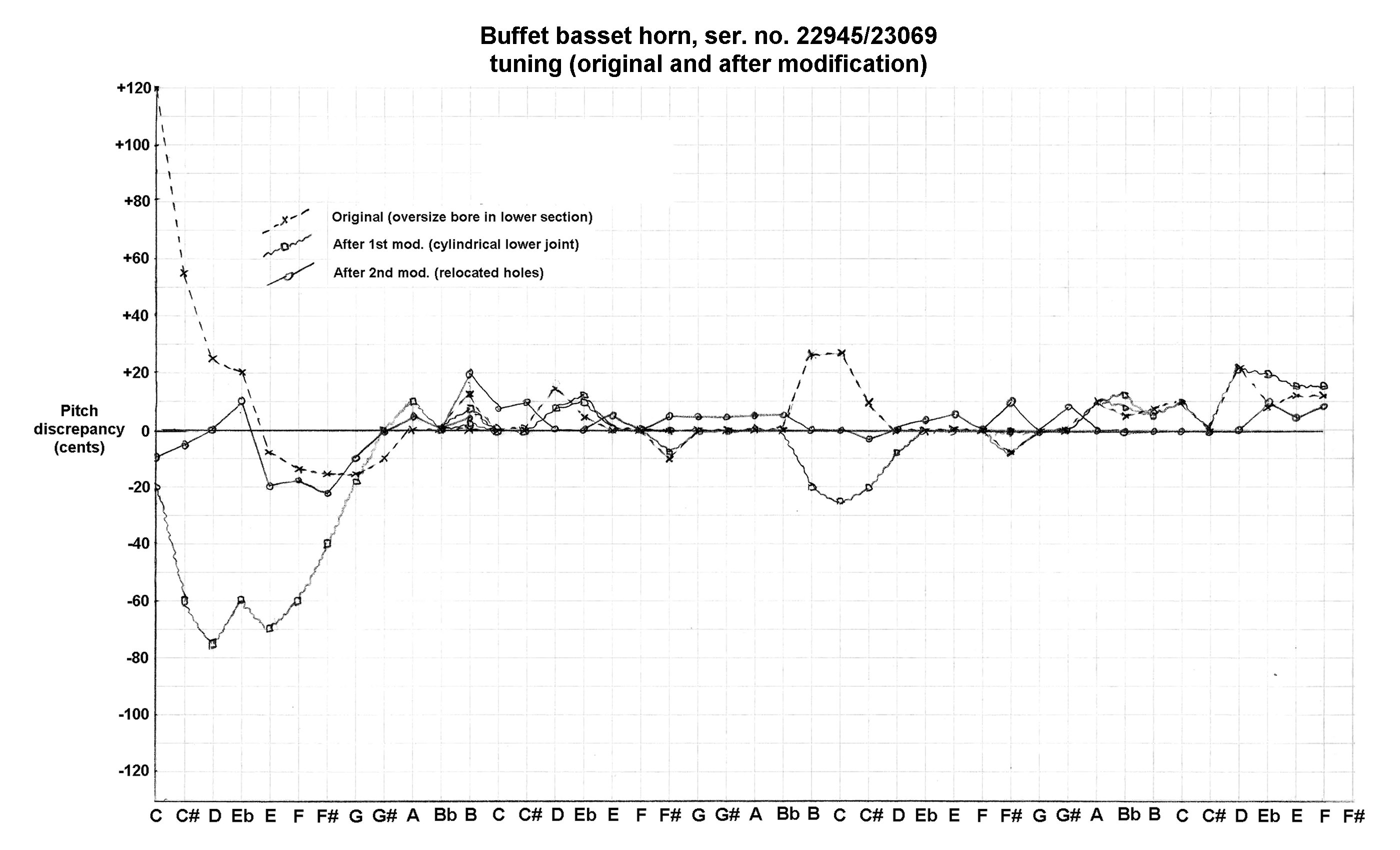Stephen
Fox
|
A few years ago a customer brought in an instrument which provided a very puzzling challenge, to say the least. This description is presented as an illustration of the importance of bore shape on the playing properties of woodwind instruments, and of what can be done to improve an apparently hopeless case. The specimen in question was a small bore (supposedly; therein lies the tale!) Buffet basset horn, with the combined serial number 22945 (upper joint) and 23069 (lower joint). It was purchased in as-new condition (mismatching numbers notwithstanding) in 2005 or 2006 from a major retailer in the U.S.A. The serial numbers date it to circa 1990, around the point when Buffet changed from the old small bore basset horn design to the current medium-large bore, alto clarinet concept model. The customerís complaint was that while the horn played very well in the normal clarinet range, below low E the notes became increasingly rough, indistinct and sharp. Bottom C was not really a musical tone at all; insofar as the pitch was discernible, it could only be played in tune with the addition of an extension section (about 55mm long) between the lower joint and the bell, which came with the instrument and which appeared to be factory-made. A number of repair technicians had been consulted about the terrible bottom notes, but apart from confirming that the pads all sealed and offering unnecessary advice about mouthpieces, reeds and playing technique, they were unable to help. A quick glance inside the bore, followed by detailed measurements, revealed the likely cause of the trouble. In contrast to the normal strictly cylindrical basset horn bore, the original bore shape, depicted in the diagram below, can only be described as bizarre. The upper section (about 17cm) of the lower joint was the normal Buffet small bore diameter, 15.65mm. Below that, it expanded rapidly to a much larger cylindrical diameter of 18.4mm - roughly the bore size of an alto clarinet - for the lower half of the joint. The upper joint was similarly abnormal, though on a smaller scale: 15.65mm diameter over the lower 6cm, then a sudden jump to a somewhat larger diameter of 16.0mm, then finally a slight conical expansion towards the top end:
The tone holes showed further anomalies. Three holes on the lower joint - F/C, E/B and low Eb - were located considerably lower on the body than on other Buffet basset horns (small or large bore), by significant amounts (about 20mm for F/C and E/B, 10mm for Eb). (We note that on French soprano clarinets, the flaring of the lower joint bore makes it necessary to move the F/C tone hole down the bore from where it would otherwise be placed.) In addition, the lowest holes - Eb, D and C# - were much smaller than normal; the C# hole was less than 8mm in diameter, for example. These features of the tone holes made it clear that the weirdly-shaped bore was not the result of later tinkering; the instrument must have left the factory that way. Whatever the genesis of the problem child, clearly its behaviour was impossible, so radical remedial surgery was called for. Following measurement and intonation testing, the first modification was to line the expanded section of the lower joint bore with a sleeve (made of grenadilla) and to ream it to a constant diameter of 15.65mm. The horn was then reassembled and tested, and the intonation measured again. The bottom notes now played as they should, with a clear tone and well defined pitch. However, the low notes from G on down were now very flat, as were B, C and C# in the second register. The second phase was to plug up the low F/C, E/B and Eb tone holes and to redrill them in their normal positions. The Eb, D and C# holes were also enlarged to more conventional dimensions, and the lower joint was shortened by 5mm at the bottom end. Addition of a Schmidt-type throat Bb resonance key, with replacement of the register tube by one of correct dimensions, allowed further improvement of the E/B, F/C and F#/C# 12ths. No attempt was made to correct the bore of the upper joint, since it did not seem to have any significant detrimental effects. The bell was also replaced by a downward-pointing clarinet style bell, but this had no bearing on the intonation. The fruit of these alterations is shown in the following tuning graph. The three lines and sets of points display the tuning (1) in the original state, (2) after correcting the lower joint bore, and (3) after relocating and resizing the lower tone holes:
While as with any clarinet, absolute perfection is impossible to achieve, the dramatic improvement is clear. What the graph cannot show is the transformation of the tone and response of the bottom notes. The design lesson to be learned from this case is that while the bore of the clarinet can function with some departures from a strict cylinder, it definitely does not work to graft a larger diameter cylinder onto a smaller diameter one. Thus, for example, it is unfortunately not workable to make a separate, removable basset extension for a French bore soprano clarinet, because of the expansion of the bore in the lower joint (yes, itís been tried!). It remains to investigate
why such an instrument would have been made, and even more, how it could
have passed inspection and found its way into the retail pipeline.
To date it has been impossible to obtain any information from Buffet about
it; in the absence of direct testimony, we can only speculate that it (or
possibly they, in view of the mixed serial numbers) was an experimental
prototype of a misguided new design that somehow escaped, like Frankensteinís
monster, to wreak havoc on the unsuspecting public.
© 2010 by Stephen Fox
Update, December 2013: Since the publication of this article, I've received a message from a reader in the U.K. who reported having purchased a Buffet basset horn with a similar bore shape, and hence similarly disastrous playing characteristics. So, this is not an isolated mistake, it was a deliberately designed model, albeit thankfully short lived. The moral of the story: before purchasing a Buffet basset horn, measure the bore diameter at each end, play test it, and don't assume that playing difficulties are a result of general condition, mouthpiece/reed or playing technique. |
|||||||||

